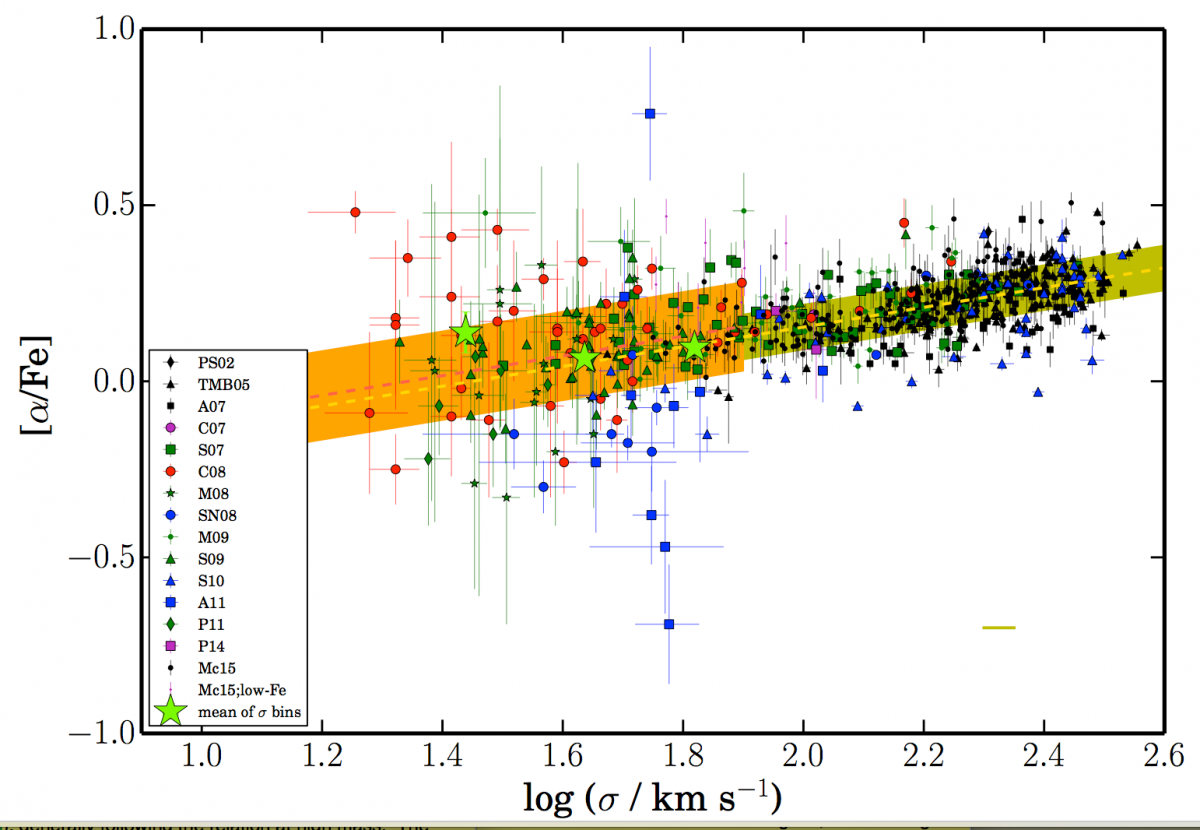Galaxies are the basic units of cosmic structures. Studying galactic star formation histories is important for understanding the evolution of baryonic matter in the Universe. Most early-type galaxies (ETGs) stopped forming stars long ago, and they record the star formation processes and quenching scenarios at early epoch. A powerful tracer of these early processes is the alpha-to-iron abundance ratio ([alpha/Fe]), which is an indicator of star formation timescale (tSF) under the assumption of a universal stellar initial mass function and constant supernova properties. Galaxies with shorter tSF would have higher [alpha/Fe], and [alpha/Fe] is sensitive to tSF when tSF is relatively short.
Empirically, among massive ETGs, there is a tight positive correlation between [alpha/Fe] and central velocity dispersion (sigma) (e.g. Thomas et al., 2005). It indicates that more massive ETGs have shorter tSF and stopped their star formation earlier, which suggests mass-dependent quenching mechanisms of them. Because instead of mass, low-mass ETGs are presumably quenched by environmental processes (Peng et al. 2010) or by feedback from supernova explosions and stellar winds (e.g., Hopkins et al. 2011), the behavior of their [alpha/Fe]-sigma relation is intriguing.
| |
| |
 |
Figure 1: Relation between [alpha/Fe] derived from single stellar population models and sigma of ETGs. Different colours and symbols represent different subsamples, and the references are listed in the legend. The galaxies in the sample are divided into two groups by log(sigma) = 1.9. The green stars in the low-mass range show the weighted mean of three bins of sigma, which are log(sigma) = 1.2-1.5, 1.5-1.7, and 1.7-1.9. The yellow dashed line and band display the relation and intrinsic scatter fitted by the high-sigma group, and the ones fitted by the low-sigma group are displayed in orange.
To investigate the [alpha/Fe] at low masses, astronomers from Kavli Institute for Astronomy and Astrophysics (KIAA) at Peking University assemble the [alpha/Fe] and sigma measurements from the literature of 708 ETGs across a wide range in mass and environment. They find that the [alpha/Fe]-sigma relation at low masses generally follows the tight correlation in the high-mass range, but has significantly larger intrinsic scatter. However, the large scatter is essentially caused by the ETGs from the highest and lowest density environments.
The majority of the low-mass sample are quenched galaxies located in moderate-density environments (green symbols). They have both similar relation and similar intrinsic scatter to that of massive ETGs. On the other hand, the [alpha/Fe] of low-mass galaxies from the most massive relaxed galaxy clusters (red symbols) and galaxy groups (blue symbols), which are the environments with the highest and lowest density in the sample, are averagely elevated and suppressed respectively. These suggest that the low-mass ETGs quenched their star formation earlier in very dense environments, and have more extended star formation histories in low-density environments. Moreover, the subsamples from extreme environments have large intrinsic scatter in their [alpha/Fe] distributions, implying stochasticity in their chemical evolution.
Based on the unprecedentedly large dataset, this work for the first time shows a mass-dependent tSF of most ETGs across a wide mass range on average. However, the low-mass ETGs depart from this standard relation with large intrinsic scatter in extreme environments. The higher and lower mean [alpha/Fe] suggest earlier quenching in very dense environments and more extended star formation histories in low-density environments, and the large scatter implies stochasticity in their chemical evolution.
Published paper:
Yiqing Liu, Luis C. Ho, & Eric Peng, 2016, Astrophysical Journal Letters, 829L, 26
The Influence of Environment on the Chemical Evolution in Low-mass Galaxies